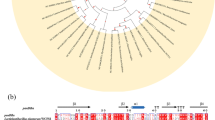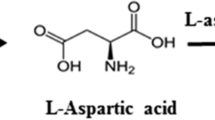Abstract
The α-acetolactate decarboxylase (ALDC) can reduce diacetyl fleetly to promote mature beer. A safe strain Bacillus subtilis WB600 for high-yield production of ALDC was constructed with the ALDC gene saald from Staphylococcus aureus L3-15. SDS-PAGE analysis revealed that S. aureus α-acetolactate decarboxylase (SaALDC) was successfully expressed in recombinant B. siutilis strain. The enzyme SaALDC was purified using Ni-affinity chromatography and showed a maximum activity at 45 °C and pH 6.0. The values of K m and V max were 17.7 μM and 2.06 mM min−1, respectively. Due to the unstable property of SaALDC at low pH conditions that needed in brewing process, site-directed mutagenesis was proposed for improving the acidic stability of SaALDC. Homology comparative modeling analysis showed that the mutation (K52D) gave rise to the negative-electrostatic potential on the surface of protein while the numbers of hydrogen bonds between the mutation site (N43D) and the around residues increased. Taken together the effect of mutation N43D-K52D, recombinant SaALDCN43D-K52D showed dramatically improved acidic stability with prolonged half-life of 3.5 h (compared to the WT of 1.5 h) at pH 4.0. In a 5-L fermenter, the recombinant B. subtilis strain that could over-express SaALDCN43D-K52D exhibited a high yield of 135.8 U mL−1 of SaALDC activity, about 320 times higher comparing to 0.42 U mL−1 of S. aureus L3-15. This work proposed a strategy for improving the acidic stability of SaALDC in the B. subtilis host.










Similar content being viewed by others
References
Arnold K, Bordoli L, Kopp J, Schwede T (2006) The SWISS-MODEL workspace: a web-based environment for protein structure homology modelling. Bioinformatics 22:195–201
Biasini M et al (2014) SWISS-MODEL: modelling protein tertiary and quaternary structure using evolutionary information. Nucleic Acids Res 42:W252–W258
Bordoli L, Kiefer F, Arnold K, Benkert P, Battey J, Schwede T (2009) Protein structure homology modeling using SWISS-MODEL workspace. Nat Protoc 4:1–13
Bradford MM (1976) A rapid and sensitive method for the quantitation of microgram quantities of protein utilizing the principle of protein-dye binding. Anal Biochem 72:248–254
Curic M, Stuer-Lauridsen B, Renault P, Nilsson D (1999) A general method for selection of alpha-acetolactate decarboxylase-deficient Lactococcus lactis mutants to improve diacetyl formation. Appl Environ Microbiol 65:1202–1206
Diderichsen B, Wedsted U, Hedegaard L, Jensen BR, Sjoholm C (1990) Cloning of aldB, which encodes alpha-acetolactate decarboxylase, an exoenzyme from Bacillus brevis. J Bacteriol 172:4315–4321
Dulieu C, Moll M, Boudrant J, Poncelet D (2000) Improved performances and control of beer fermentation using encapsulated alpha-acetolactate decarboxylase and modeling. Biotechnol Prog 16:958–965
Garmyn D, Monnet C, Martineau B, Guzzo J, Cavin JF, Divies C (1996) Cloning and sequencing of the gene encoding alpha-acetolactate decarboxylase from Leuconostoc oenos. FEMS Microbiol Lett 145:445–450
Goelling D, Stahl U (1988) Cloning and expression of an alpha-acetolactate decarboxylase gene from Streptococcus lactis subsp. diacetylactis in Escherichia coli. Appl Environ Microbiol 54:1889–1891
GoupilFeuillerat N, CocaignBousquet M, Godon JJ, Ehrlich SD, Renault P (1997) Dual role of alpha-acetolactate decarboxylase in Lactococcus lactis subsp. lactis. J Bacteriol 179:6285–6293
Goupil-Feuillerat N, Corthier G, Godon JJ, Ehrlich SD, Renault P (2000) Transcriptional and translational regulation of alpha-acetolactate decarboxylase of Lactococcus lactis subsp. lactis. J Bacteriol 182:5399–5408
Guo W, He X, Tie C, Zhang B (2001) Expression of alpha-acetolactate decarboxylase gene from Bacillus subtilis in Brewer’s yeast. Wei Sheng Wu Xue Bao 41:105–108
Huang L et al (2012) Improving the acidic stability of a methyl parathion hydrolase by changing basic residues to acidic residues. Biotechnol Lett 34:1115–1121
Joshi MD, Sidhu G, Pot I, Brayer GD, Withers SG, McIntosh LP (2000) Hydrogen bonding and catalysis: a novel explanation for how a single amino acid substitution can change the pH optimum of a glycosidase. J Mol Biol 299:255–279
Kisrieva YS, Serebrennikov VM, Zagustina NA, Bezborodov AM (2000) Isolation and purification of acetolactate synthase and acetolactate decarboxylase from the culture of Lactococcus lactis. Appl Biochem Microbiol 36:109–114. doi:10.1007/Bf02737903
Kunst F et al (1997) The complete genome sequence of the gram-positive bacterium Bacillus subtilis. Nature 390:249–256
Laemmli UK (1970) Cleavage of structural proteins during the assembly of the head of bacteriophage T4. Nature 227:680–685
Le Nours J, Ryttersgaard C, Lo Leggio L, Ostergaard PR, Borchert TV, Christensen LL, Larsen S (2003) Structure of two fungal beta-1,4-galactanases: searching for the basis for temperature and pH optimum. Protein Sci 12:1195–1204
Lei H, Zheng L, Wang C, Zhao H, Zhao M (2013) Effects of worts treated with proteases on the assimilation of free amino acids and fermentation performance of lager yeast. Int J Food Microbiol 161:76–83. doi:10.1016/j.ijfoodmicro.2012.11.024
Liu Y, Cui W, Liu Z, Cui Y, Xia Y, Kobayashi M, Zhou Z (2014) Effect of flexibility and positive charge of the C-terminal domain on the activator P14 K function for nitrile hydratase in Pseudomonas putida. FEMS Microbiol Lett 352:38–44
Loken JP, Stormer FC (1970) Acetolactate decarboxylase from Aerobacter aerogenes. Purif Prop Eur J Biochem 14:133–137
Marlow VA, Rea D, Najmudin S, Wills M, Fulop V (2013) Structure and mechanism of acetolactate decarboxylase Acs. Chem Biol 8:2339–2344
Monnet C, Corrieu G (2007) Selection and properties of alpha-acetolactate decarboxylase-deficient spontaneous mutants of Streptococcus thermophilus. Food Microbiol 24:601–606
Monnet C, Aymes F, Corrieu G (2000) Diacetyl and alpha-acetolactate overproduction by Lactococcus lactis subsp lactis biovar diacetylactis mutants that are deficient in alpha-acetolactate decarboxylase and have a low lactate dehydrogenase activity. Appl Environ Microbiol 66:5518–5520
O’Sullivan SM, Condon S, Cogan TM, Sheehan D (2001) Purification and characterisation of acetolactate decarboxylase from Leuconostoc lactis NCW1. FEMS Microbiol Lett 194:245–249
Phalip V, Monnet C, Schmitt P, Renault P, Godon JJ, Divies C (1994) Purification and Properties of the Alpha-Acetolactate Decarboxylase from Lactococcus-Lactis Subsp Lactis Ncdo-2118. FEBS Lett 351:95–99. doi:10.1016/0014-5793(94)00820-5
Qin YJ, Gao D, Wang ZN (2000) Alpha-acetolactate decarboxylase from B. licheniformis AS10106: cloning and expression gene in E. coli and S. cerevisiae Yi chuan xue bao =. Acta genetica Sinica 27:165–169
Repizo GD, Mortera P, Magni C (2011) Disruption of the alsSD operon of Enterococcus faecalis impairs growth on pyruvate at low pH. Microbiology 157:2708–2719
Roy A, Kucukural A, Zhang Y (2010) I-TASSER: a unified platform for automated protein structure and function prediction. Nat Protoc 5:725–738
Roy A, Yang JY, Zhang Y (2012) COFACTOR: an accurate comparative algorithm for structure-based protein function annotation. Nucleic Acids Res 40:W471–W477
Sambrook J, Russell DW (2001) Molecular cloning: a laboratory manual. Cold spring harbor laboratory press
Schallmey M, Singh A, Ward OP (2004) Developments in the use of Bacillus species for industrial production. Can J Microbiol 50:1–17
Sone H, Fujii T, Kondo K, Shimizu F, Tanaka J, Inoue T (1988) Nucleotide sequence and expression of the Enterobacter aerogenes alpha-acetolactate decarboxylase gene in brewer’s yeast. Appl Environ Microbiol 54:38–42
Spizizen J (1958) Transformation of biochemically deficient strains of Bacillus subtilis by deoxyribonucleate. Proc Natl Acad Sci USA 44:1072–1078
Suihko ML, Blomqvist K, Penttila M, Gisler R, Knowles J (1990) Recombinant brewer’s yeast strains suitable for accelerated brewing. J Biotechnol 14:285–300
Yamano S, Tanaka J, Inoue T (1994) Cloning and expression of the gene encoding alpha-acetolactate decarboxylase from Acetobacter aceti ssp. xylinum in brewer’s yeast. J Biotechnol 32:165–171
Yan Y, Lee CC, Liao JC (2009) Enantioselective synthesis of pure (R, R)-2,3-butanediol in Escherichia coli with stereospecific secondary alcohol dehydrogenases. Org Biomol Chem 7:3914–3917
Yang H, Liu L, Shin HD, Chen RR, Li J, Du G, Chen J (2013) Structure-based engineering of histidine residues in the catalytic domain of alpha-amylase from Bacillus subtilis for improved protein stability and catalytic efficiency under acidic conditions. J Biotechnol 164:59–66
Zhang Y (2008) I-TASSER server for protein 3D structure prediction. BMC Bioinform 9:14. doi:10.1186/1471-2105-9-40
Acknowledgments
This work was supported by the National Basic Research Program of China (973 Program) (12CB720806), the National Natural Science Foundation of China (21276110), the High-tech Research and Development Programs of China (2014AA021304), the Research Project of Chinese Ministry of Education (113033A), the Fundamental Research Funds for the Central Universities (JUSRP51306A), the Project Funded by the Priority Academic Program Development of Jiangsu Higher Education Institutions, the 111 Project (No. 111-2-06), and the Jiangsu province “Collaborative Innovation Center for Advanced Industrial Fermentation” industry development program. We thank for Rongxia Zhang and Lab of Brewing Science and Technology of Jiangnan University for performing the experiments of beer fermentation with SaALDCN43D-K52D.
Conflict of interest
The authors declare no conflict of interest.
Author information
Authors and Affiliations
Corresponding author
Electronic supplementary material
Below is the link to the electronic supplementary material.
Rights and permissions
About this article
Cite this article
Zhang, X., Rao, Z., Li, J. et al. Improving the acidic stability of Staphylococcus aureus α-acetolactate decarboxylase in Bacillus subtilis by changing basic residues to acidic residues. Amino Acids 47, 707–717 (2015). https://doi.org/10.1007/s00726-014-1898-5
Received:
Accepted:
Published:
Issue Date:
DOI: https://doi.org/10.1007/s00726-014-1898-5




